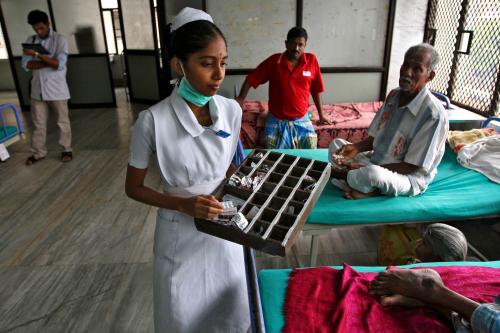Content from the Brookings Institution India Center is now archived. After seven years of an impactful partnership, as of September 11, 2020, Brookings India is now the Centre for Social and Economic Progress, an independent public policy institution based in India.
Views expressed in this article are personal.
In wake the of the growing COVID-19 crisis and the strain on healthcare resources, India’s finance minister Nirmala Sitharaman on March 26 announced that District Mineral Foundation (DMF) funds can be used by state governments to augment healthcare. This includes supplementing healthcare facilities, screening and testing requirements, and any other support that might be required.
The announcement that DMF funds will be a component of the government’s coronavirus relief package has generated a lot of discussion. In the light of this discussion, it is important to look at what the DMF funds were meant for and how they can be used effectively.
DMF was instituted exactly five years ago, in March 2015, through an amendment to India’s central mining law, the Mines and Minerals (Development and Regulation) Act (MMDR Amendment Act 2015). It has been conceptualised as a benefit-sharing mechanism with mining-affected communities, recognising them as partners in natural resource-led development. Set up as a non-profit trust in all mining districts of India, DMF comes with the precise objective to ‘work for the interest and benefit of people and areas affected by mining’, through a participatory process. It was also aligned with the important the Pradhan Mantri Khanij Kshetra Kalyan Yojana (PMKKKY) scheme, that was launched in September 2015 to implement various developmental projects and welfare programmes in mining-affected areas with DMF funds.
The funds of DMF trust come through a contribution from mining companies operating in the district. Companies are required to pay 30% equivalent of the royalty amount for leases granted before 2015, and 10% for leases granted after that through auction mechanism. This must be paid for the lifetime of their operation. In just a five-year period, the cumulative accrual in DMF trusts is nearly Rs. 35,925 crores, as per available information with the Ministry of Mines. Government estimates suggest that about Rs. 6,000 crores are likely to be collected by DMFs annually. The DMF fund, therefore, is the largest non-tagged, non-plan money available for the benefit of some of India’s poorest and marginalised populations living in mining areas. The money is to be spent on improving human development indicators through investments in sectors such as healthcare, education, women and child development, improving sustainable livelihood and income opportunities in these areas and ensuring long-term security of the mining-affected communities. These have been identified as ‘high priority’ issues for DMF spending by the centre as well as state governments under the law.
Despite opportunities, the utilisation of funds in most states has been low. As per the Ministry of Mines, only Rs. 12,414 crores have been spent as of January 2020, which is only about 35% of the total amount.
On March 28, the Ministry of Mines issued directives on the proportion of DMF funds that can be used by state governments to fight the COVID-19 crisis. The amount has been capped at 30% of funds left unused with DMFs. Given the unspent amount is Rs 23,511 crore for all DMFs in the country, the maximum amount for COVID-19 roughly translates to more than Rs.7,000 crores. For top mining states like Odisha, the collective amount available is more than Rs. 2,000 crores (Table 1).
Table 1: Potential DMF funds to fight COVID-19 in some top mining states as per central government directives
|
State name |
Total DMF collection (Rs. cr) |
Unspent DMF fund (Rs. cr) |
Amount can be utilised for COVID-19 (Rs. cr) |
| Odisha |
9,501 |
6,707 |
2,012 |
| Jharkhand |
5,181 |
2,772 |
832 |
| Chhattisgarh |
4,980 |
1,622 |
487 |
| Rajasthan |
3,514 |
2,766 |
830 |
| Madhya Pradesh |
2,864 |
2,012 |
604 |
| Telangana |
2,774 |
2,282 |
685 |
| Karnataka |
1,842 |
1,522 |
457 |
| Maharashtra |
1,728 |
1,120 |
336 |
Source: Ministry of Mines, Government of India, DMF fund status up to January 2020.
While DMF administration comes under the aegis of districts and states, the Ministry of Mines has issued these directions under Section 20 of the MMDR Amendment Act. The letter issued by the Ministry of Mines to all state Chief Secretaries clarifies that such power has been exercised by the government in line with the emergent national interest to combat the COVID-19 pandemic.
The logistics of the DMF fund use are still being figured out by most states and districts as the situation is still unfolding. The centre’s directions broadly specify that DMF funds should be used for COVID-19 in those districts where at least one COVID-19 positive patient has been detected. As per official sources from states such as Chhattisgarh and Tamil Nadu, the state governments may issue some directions to districts in the coming days depending on the local situation.
Opportunities to use DMF funds effectively
DMF funds can be utilised to scale up healthcare intervention across states, particularly at the local level. While the disease clusters are still concentrated in the cities and major town centres, the reverse migration of labourers to rural areas gives reason for concern of community transmission. Given the poor status of healthcare resources in most of rural and remote areas, taking early measures is critical.
For example, most of these districts have a severe shortfall of primary healthcare services such as the primary healthcare centres (PHCs) or community health centres (CHCs). As per district health officials, in most areas, these facilities already operate at twice their capacities [i]. Additionally, there is a serious issue with access to these healthcare facilities. For example, according to the Brookings India Health Monitor (2018 estimates), in Odisha’s Keonjhar district, only 4% villages have a PHC within 5 kilometer (km) radius, and only 3% villages have access to a CHC within 10 km radius. Similarly, in Jharkhand’s West Singhbhum district, only about 14% of villages have PHCs within a 5 km radius.
Given this, there have been clear concerns about how DMF funds were being spent in the mining areas. Between 2016-2018, the trends were problematic. Barring few, in most states and districts, a primary focus of expenditure has been on physical infrastructure, including major roads. Expenditure in ‘high priority’ sectors such as healthcare, women and child development, livelihood support, has been grossly sub-optimal as compared to the need. For example, in Jharkhand, until 2018, healthcare sector accounted for only 0.22% of the total spending, in Chhattisgarh 7.8% and in Odisha about 15% (largely owing to one major hospital in Keonjhar) [ii].
However, over the past year there has been some revised focus on healthcare resources. As per information from officials, media sources and advertisements, some districts are trying to bridge the gap in healthcare staff and service delivery. These include districts like Keonjhar, Sundargarh, West Singhbhum, Chatra, Bijapur, Dantewada etc. A primary measure has been hiring doctors as well as trying to reach out to remote areas through mobile health service delivery systems such as mobile medical units, motorbike ambulances etc.
The DMF funds now can be crucial for these districts. The money can be used to procure testing equipment, personal protective equipment (PPE) for healthcare workers, train frontline workers and increase capacity of ASHA (accredited social health activists) workers in these areas, engage paramedical staff on contractual basis, pay volunteers from local non-profits and village groups to improve community outreach on COVID-19 do’s and don’ts.
Keonjhar district has just sanctioned Rs. 7.5 crores towards such efforts. As per district sources, this will be used for upgradation of primary healthcare facilities in the district, establishment of isolation facilities, procure PPEs, train healthcare staff to combat COVID-19 and hire additional resources as required [iii].
The districts and states also should take this as a lesson to improve the healthcare situation, particularly in the rural areas. While the preparedness for emergencies is important, the overall strengthening of rural healthcare is critical to provide sustained care to the country’s poorest and most marginalised citizens. Healthcare must be a major component of DMF plan in the coming years.
In the coming days, the districts may also consider providing direct cash transfers to poor families in these areas, particularly to labourers whose livelihood has been affected by the measures to contain the disease. The overall DMF fund available with states and districts provides substantial scope. However, a proper system to do this needs some consideration. There are emerging concerns about direct benefit transfer (DBT), as it depends on the Jan Dhan-Aadhaar-Mobile (JAM) architecture, which allows direct transfer of government-sanctioned welfare funds to bank accounts of the beneficiaries. However, many people in rural areas, particularly migrant laborers, do not have bank accounts.
As the COVID-19 situation keeps evolving, proper mechanisms of utilisation of relief funds to tackle the health crisis, as well as to provide economic support to some of the poorest will be critical. The fight, as many experts are predicting, is a long haul.
[i] Srestha Banerjee et al, 2018, People First: District Mineral Foundation (DMF), Status Report 2018, Centre for Science and Environment, New Delhi
[ii] ibid
[iii] https://orissadiary.com/district-mineral-foundation-approves-7-5-cr-rupees-to-fight-carona-decease-in-kendujhar-district/
The Brookings Institution is committed to quality, independence, and impact.
We are supported by a diverse array of funders. In line with our values and policies, each Brookings publication represents the sole views of its author(s).






Commentary
Utilising District Mineral Foundation funds to fight the COVID-19 crisis in India: Current and future opportunities
April 6, 2020